Aluminum-body Ford F-150 crew cab aces IIHS tests
July 30, 2015
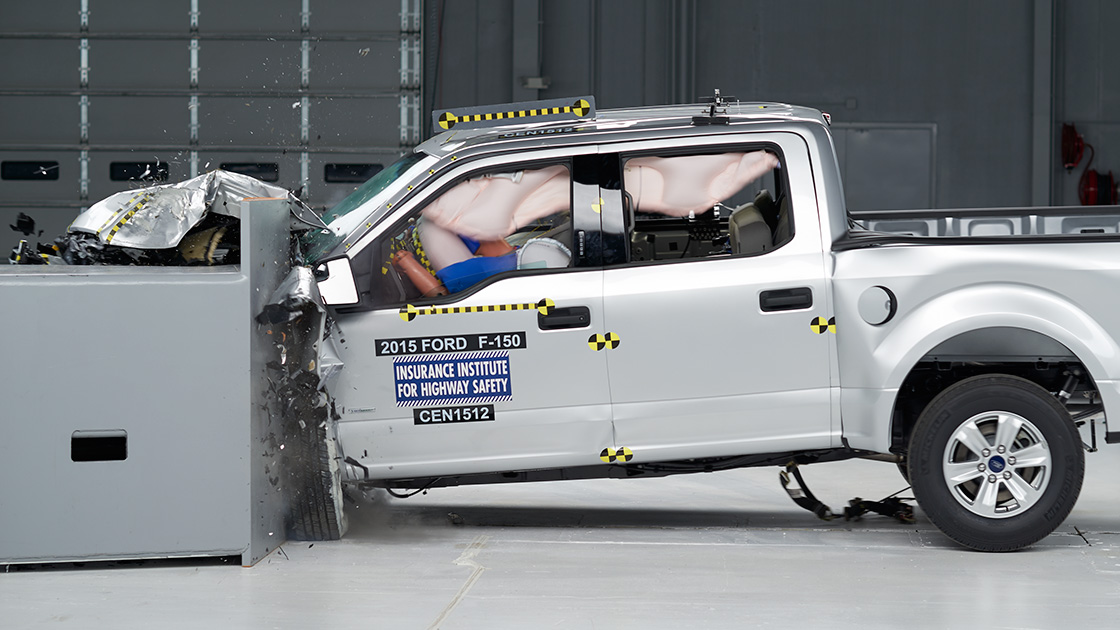
The aluminum-body 2015 Ford F-150 crew cab swept the full slate of IIHS crashworthiness evaluations to qualify for a 2015 Top Safety Pick award. The F-150 extended cab turned in a good performance in 4 of 5 assessments but stumbled in the small overlap front test. The results are the first ratings for large pickups in a group the Institute is evaluating this year.
The F-150 crew cab, which Ford calls the SuperCrew, earns good ratings for occupant protection in all five IIHS crashworthiness evaluations — small overlap front, moderate overlap front, side, roof strength and head restraint evaluations. The extended cab, or SuperCab, earns good ratings in the moderate overlap front, side, roof strength and head restraint evaluations but just a marginal rating for occupant protection in a small overlap front crash.
Crew-cab pickups have four full doors and two full rows of seating. Extended cabs have two full front doors, two smaller rear doors and compact second-row seats. Both cab types make up a bigger share of the pickup truck market than regular cabs. Crew cabs accounted for 50 percent, extended cabs 43 percent, and regular cabs 7 percent of 2013 model pickups in HLDI's vehicle database.
The Institute picked the F-150 to test first because it is not only the best-selling vehicle in the U.S. but also the first mass-market vehicle with an all-aluminum body. Automakers have used the lightweight metal to build engines, wheels, hoods, fenders and trunk lids for more than 20 years, but its use in the whole vehicle body is uncommon. Other mostly aluminum offerings are luxury models — the Acura NSX, Audi A8, Range Rover and Tesla Model S, for example.
Ford's choice of aluminum for the F-150 body means the pickup is about 500 pounds lighter than the 2014 steel-body F-150. The underlying frame — the workhorse of crash protection — still is made of steel.
"Consumers who wondered whether the aluminum-body F-150 would be as crashworthy as its steel-body predecessor can consider the question answered," says David Zuby, the Institute’s chief research officer.
Both the crew cab and extended cab F-150 pickups are rated basic for front crash prevention when equipped with Ford's optional forward collision warning system, which meets performance criteria set by the National Highway Traffic Safety Administration (NHTSA). The F-150 crew cab isn't eligible for Top Safety Pick+ because it lacks an autonomous braking system.
Vehicles that earn a good or acceptable rating for small overlap protection and good ratings in the moderate overlap front, side, roof strength and head restraint evaluations qualify for Top Safety Pick. To earn Top Safety Pick+, vehicles also must have an available autobrake system that earns an advanced or superior rating.
2015 Ford F-150 ratings
|
Top Safety Pick 
Crew cab |
 Extended cab |
|
|---|---|---|
| Crashworthiness | ||
| G | Small overlap front overall rating | M |
| G | Structure | P |
| G | Restraints & kinematics | A |
| Dummy injury measurements | ||
| G | Head & neck | G |
| G | Chest | G |
| G | Hip & thigh | A |
| G | Lower leg & foot | A |
| G | Moderate overlap front | G |
| G | Side | G |
| G | Roof strength | G |
| G | Head restraints & seats | G |
|
Front crash prevention Basic with optional equipment |
Front crash prevention |
Front crash prevention Basic with optional equipment |
Key
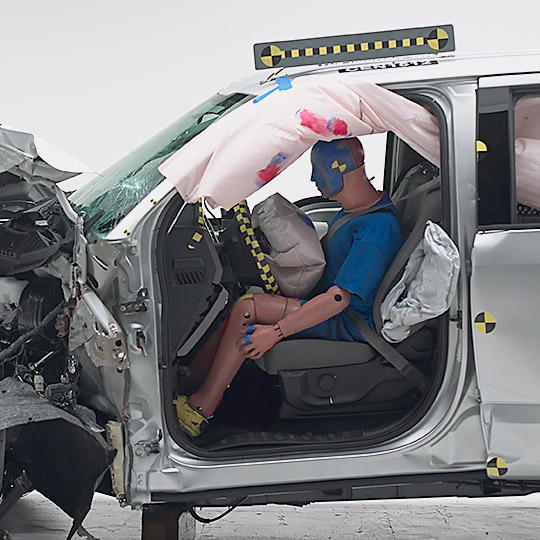
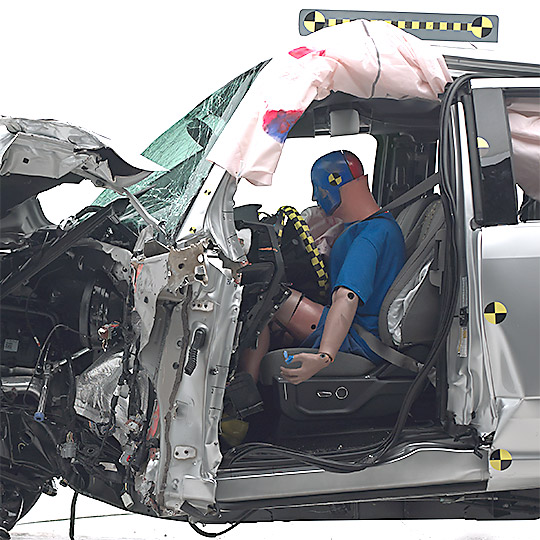
Why two models were evaluated
NHTSA evaluated the crew cab, extended cab and regular cab versions of the 2015 F-150. Each received the top 5-star safety rating for front and side crash protection in the agency's New Car Assessment Program and 4 stars for rollover protection.
For vehicles with multiple body styles, the Institute typically evaluates the one with the biggest sales. Initially, only the F-150 crew cab was on the schedule.
"After we tested the crew cab in the spring, questions were raised about the extended cab's ability to match the crew cab's good small overlap performance. We did some initial analysis and decided to test the extended cab, too," Zuby says.
While a departure from the Institute's usual practice, the F-150 merits a closer look.
"For starters, there's been lots of buzz around the release of the first aluminum-body pickup and how it would perform in crash tests," Zuby says. "What's more, even the lower-selling extended cab sales top those of many of the passenger vehicles we rate."
To provide consumers with more safety information, IIHS plans to rate multiple variants of the other pickups slated for tests this year.
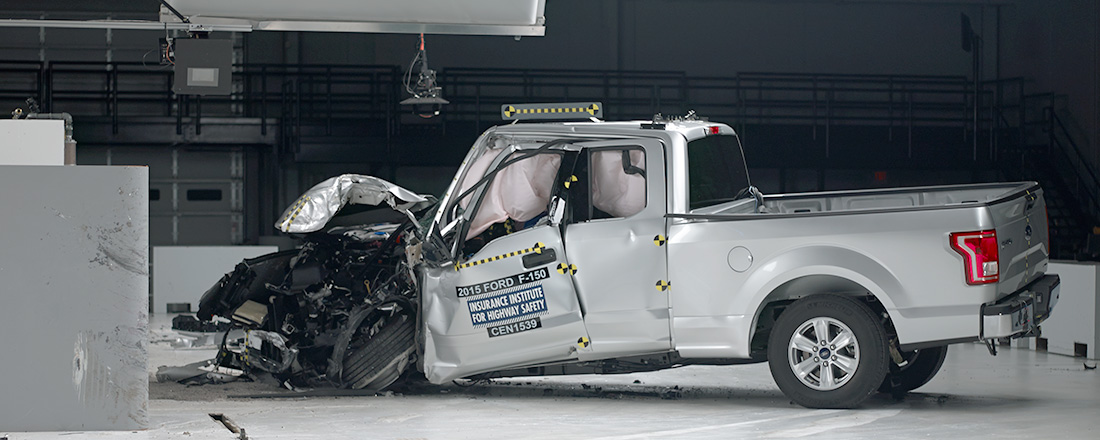
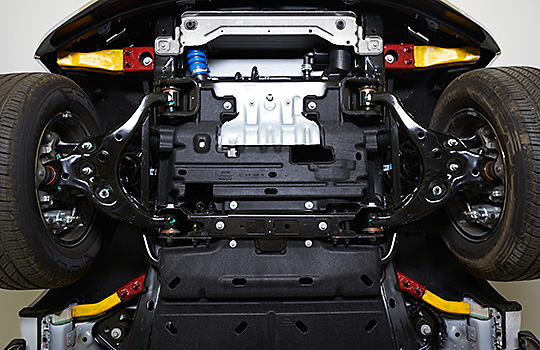
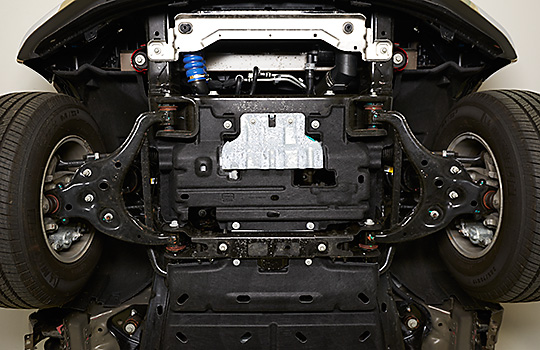
Striking differences in small overlap test
In the small overlap front test, each F-150 traveled at 40 mph toward a 5-foot-tall rigid barrier. Twenty-five percent of the pickup's total width struck the barrier on the driver side, where a Hybrid III dummy representing an average-size man was positioned at the steering wheel. The test replicates what happens when the front corner of a vehicle collides with another vehicle or an object such as a tree or a utility pole.
The two versions of the F-150 had markedly different outcomes. Inspect the images from the tests and it's easy to see why the crew cab is rated good and the extended cab is rated marginal.
"In a small overlap front crash like this, there's no question you'd rather be driving the crew cab than the extended cab F-150," Zuby says.
The crew cab's occupant compartment remained intact. The front-end structure crumpled in a way that spared the occupant compartment significant intrusion and preserved survival space for the driver.
Measures recorded on the test dummy indicated low risk of injuries to the dummy's head, chest, legs and feet. The front and side curtain airbags worked together to keep the dummy's head from contacting injury-producing stiff interior structures or outside objects. The dummy's head loaded the front airbag, which stayed in place until the dummy rebounded.
The extended cab is a different story. Intruding structure seriously compromised the driver's survival space, resulting in a poor structural rating. The toepan, parking brake and brake pedal were pushed back 10-13 inches toward the dummy, and the dashboard was jammed against its lower legs. Measures recorded on the dummy indicated there would be a moderate risk of injuries to the right thigh, lower left leg and left foot in a real-world crash of this severity.
The steering column was pushed back nearly 8 inches and came dangerously close to the dummy's chest. The dummy's head barely contacted the front airbag before sliding off to the left and hitting the instrument panel.
"Ford added structural elements to the crew cab's front frame to earn a good small overlap rating and a Top Safety Pick award but didn't do the same for the extended cab," Zuby observes. "That shortchanges buyers who might pick the extended cab thinking it offers the same protection in this type of crash as the crew cab. It doesn't."
The Institute has briefed Ford on the results. In a statement, the manufacturer said, "Ford is evaluating possible changes to the extended cab for small offset performance."
Moderate overlap, side and roof tests
The Institute assigned the crew cab and extended crew models good ratings for occupant protection in a moderate overlap front crash based on test data shared by Ford for both cab styles as part of the Institute's front crash-test verification process. The F-150 qualifies for the program because the earlier-generation models were rated good in this test.
In the side impact test for both models, measures taken from both the driver dummy and the passenger dummy seated in the rear seat indicated low risk of significant injuries in a real-world crash like this one. The side curtain airbag deployed from the roof to protect the dummies' heads from hitting any hard structures, including the intruding 3,300-pound SUV-like test barrier striking the driver side at 31 mph.
The crew cab's roof withstood a force of nearly 6 times the pickup's weight and the extended cab's roof withstood a force of 5.3 times the pickup's weight, an indication that the roofs will help protect occupants in rollover crashes.
The IIHS ratings apply to the 2015 SuperCrew F-150 and the SuperCab F-150 only. The Institute hasn't evaluated the 2015 regular cab.